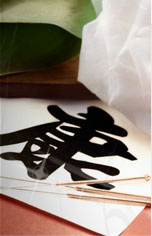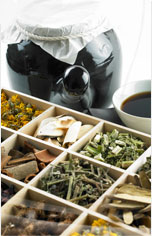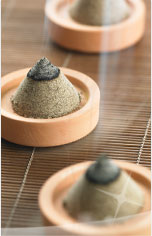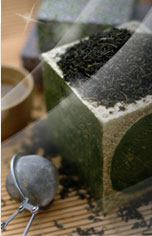| |
Acupuncture and Chinese Herbs for Morning Sickness |
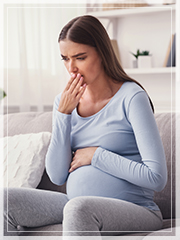
Morning sickness is nausea and vomiting that occurs during pregnancy. Despite its name, morning sickness can strike at any time of the day or night. Many pregnant women have morning sickness, especially during the first trimester. Some women never feel nauseated during their pregnancy, while some women have morning sickness throughout pregnancy.
Morning sickness may range from a mild nausea to very severe and frequent vomiting. Mild nausea and vomiting during pregnancy typically will not cause any complications to the mother or baby; various home remedies, such as snacking throughout the day and sipping ginger ale or taking over-the-counter medications to help relieve nausea. However, untreated severe nausea and vomiting can cause dehydration, an electrolyte imbalance, decreased urination and hospitalization.
Morning Sickness in TCM
In Traditional Chinese Medicine (TCM), morning sickness indicates an imbalance within Chong meridian (Penetrating vessel). Chong meridian is one of the eight Extra-ordinary Meridians of the body where Qi (the vital energy of the body) and Blood flow through. It has a deep influence on menstruation as it is the Sea of Blood; this meridian influences the supply and proper movement of the Blood in the Uterus and controls menstruation. Chong meridian starts in the area between the Kidneys, passing though the Uterus and emerging on the abdomen (at St 30 point on Stomach channel), continues its flow up to the throat, circles around the mouth.
During the first three months of pregnancy, Chong meridian undergoes profound changes, as menstruation is no longer occurring and the Blood and Essence of Chong meridian are now required to nourish the fetus, promoting the formation of all major body systems and organs. This drains the Blood, Essence and Kidney Qi of mother’s Chong meridian; the Blood and the Kidneys become relatively deficient, and the Qi of Chong meridian rebels upwards toward the stomach and the chest. Since Chong meridian is closely related to Stomach meridian through the point St 30, rebellious Qi in Chong meridian interferes with the descending action of the Stomach, leading to nausea or vomiting. Depending on the constitution and underlying imbalances the patient already has, morning sickness will have different manifestations and accompanied by various physical and mental/emotional symptoms.
NOTE: The names of organs are capitalized when referring to the entire, functional organ systems in TCM perspective: Liver, Blood, etc. The names of organs are lower-cased when referring to the distinct, biomedical organs: liver, blood, etc.
|
TCM Treatment for Morning Sickness
The fundamental principle of TCM treatment for morning sickness is always to harmonize Chong meridian, to subdue rebellious Qi, to harmonize the Stomach and to stop nausea and vomiting. Besides this basic approach, different treatment strategy will be used for different patterns of morning sickness based on the characteristics of nausea and vomiting as well as the constitution and underlying health conditions of individual patient.
As a patient’s symptoms change, the treatment will be adjusted accordingly. Healing time depends on the severity of symptoms and general health of the patient. Some patients report relief after just one session of acupuncture, while others may require more sessions to notice improvement. A typical acupuncture treatment schedule might begin with 1-2 sessions a week, tapering as the patient’s symptoms improve.
|
|
Pattern Differentiation of
Morning Sickness in TCM
- Mild nausea: Stomach Qi deficiency
- Vomiting soon after eating:
Heat and fullness
- Vomiting of dilute fluids:
Cold and deficiency
- Vomiting with retching / Vomiting of sour fluids: Liver Qi stagnation
- Vomiting of bitter fluids:
Stomach and Liver heat
|
Acupuncture
Acupuncture involves insertion of fine, sterile needles into specific points on the body which have the ability to alter various biochemical and physiological conditions in order to achieve the desired effect. Different sets of acupuncture points will be used according to the pattern differentiation diagnosis. Patients usually report that nausea resolve or at least diminish to a minimal level during the acupuncture treatment. Unlike certain antiemetic medications, there are no negative side effects associated with acupuncture.
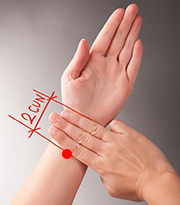
The main acupuncture point used for morning sickness is Pc 6 (Nei Guan). Pc 6 is located three fingerbreadths (2 cun) below the wrist crease on the inner forearm, in between the two tendons (palmaris longus and flexor carpi radialis) that run approximately down the center of the forearm. It is a well-known anti-nausea pressure point at which the magnetic wrist bands for motion sickness sold at most pharmacies are placed on wrists.
Patients are often instructed to apply firm pressure on this point bilaterally when they get nauseated. To find Pc 6 point, put three fingers on the inner forearm just below the wrist crease, then place the fingertip of index finger between the two tendons. Then apply downward pressure between the two tendons, massaging and stimulating the area for 30-60 seconds.
Studies have shown the effectiveness of Pc 6 in reducing nausea and vomiting. A study of women who had been hospitalized for severe pregnancy vomiting showed that there was a significantly faster reduction of nausea and more women who stopped vomiting after receiving active acupuncture treatments on Pc 6 point than after placebo acupuncture1 Another study published in 2001 also showed that acupressure on Pc 6 significantly reduce nausea and vomiting in healthy women with normal pregnancy.2
Chinese Herbal Medicine
Besides acupuncture, Chinese herbs with anti-nausea effect can be used to reduce nausea and vomiting by regulating the flow of Qi and restoring the balance of internal organs. For morning sickness, Chinese herbs are consumed as simple herbal teas which have mild smell and soothing flavor, rather than as herbal formulas. This is because some herbs used in bigger herbal formulas may have strong smell and taste and may aggravate nausea for some patients.
The Chinese herbs used most often to treat morning sickness are:
- Sha Ren (Cardamom seed)
- Sheng Jiang (Ginger)
- Zi Su Ye (Perilla leaf)
- Wu Mei (Black plum)
Lifestyle Tips
- Keep the meals small, frequent, and easy to digest. Also avoid cold, fried, fatty, salty and spicy food to minimise gastric irritation.
- Take smaller sips of fluids throughout the day to soothe the unsettled stomach and help with hydration. Mineral water with lemon juice, carbonated beverages, lemonade, chamomile tea and peppermint tea may be helpful.
- Vitamins B1 and B6 are also shown to reduce pregnancy nausea, so be sure you’re taking a prenatal multivitamin regularly.
- Overwhelming sensitivities to odors is not uncommon and can certainly set off a bout of nausea. Try to identify certain strong odors that triggers nausea and avoid them. Carrying a lemon or essential oils in your purse when you go out in public will be helpful as well.
- Resting is definitely beneficial for women experiencing morning sickness. If possible, take the time to rest at the time of day when you are most prone to feeling sick.
|
|
|

